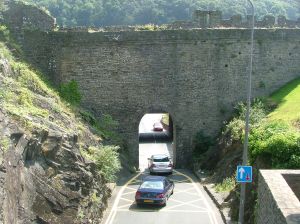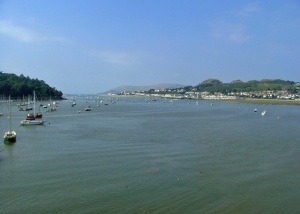Finally I’m adding a post of a day out I had in July, one of the very few nice days we’ve had since May. Anyway, for a change I decided to have a few hours in Conwy, which is only 3 miles from where I live.

Conwy is a small town dominated by a magnificent castle, and enclosed within town walls.
The castle is one of the ring of castles built in north Wales by William 1, to keep the Welsh subdued. Work started in 1283 and it was completed, along with the town walls in 1287.
Originally the walls were rendered and were white. It must have been a wonderful but frightening sight in those days.
The town was laid out in a grid pattern within the walls, and retains the same pattern today. Much of the town is still within the walls.
The picture on the left is the smallest house in Britain, which is on the quayside. It is 10ft 2ins high, 6ft wide and 8ft 4ins from back to front. Very few people cn stand upright in it’s rooms, but the last permanent occupant was a local fisherman who was over 6ft tall!


The picture on the right is Aberconwy House which dates from the 14th century. It’s a rare example of a timbered stone built merchants house and it i said to be the oldest dwelling in Conwy.

St Mary’s Church is the only building which pre-dates the castle, well part of it does. It is built on the site of a Cistercian Abbey dating from 1185.
Part of one of the walls are said to be from the Abbey, which was moved further up the Conwy valley to Maenen when William chose this place to build his castle.

The statue of Llewelyn the Great is in Lancaster Square. Llewelyn was a great Welsh Prince and founded the Abbey in 1185.

And so, on to the castle, which still dominates the town and the surrounding area.
This is the Kings tower, where William 1st had his personal chambers.
Also in the Kings tower is his personal chapel. It’s not very big, but then it was for the King and his personal retinue. He probably didn’t use it when others did, because above it is a little watching room. Here the King could sit and watch proceedings through a small window.



To the left, the slightly curving room is the Great Hall. It is 150ft long, and is curved rather than the usual rectangular shape because of the shape of the rock outcrop on which the castle is built.
The smaller room at this end of the Great Hall is the castle chapel.

This is just a photo to show how thick the walls are.

From the castle you can look down onto the suspension bridge across Afon Conwy. The bridge was built by Thomas Telford in 1822 and was a toll bridge. It was in use until the new road bridge was opened in 1958.
The other bridge which can just be seen is the tubular Railway bridge which was built by Stephenson in 1849.
Two great structures which try to compliment the castle, and certainly don’t detract from it.
The town walls are 3/4 mile long and are still mostly intact except for a short stretch by the quayside. You

can take a very pleasant walk around the walls.
The original gates in the town walls are still in use, and as you can see, they were not constructed for modern traffic. It just adds to the attractiveness of this World Heritage Site.


From the new road bridge is a great view down the estuary. In the background is the Great Orme, where Llandudno nestles beneath it.
On the right is Deganwy, with it’s marina. The strange shaped hill is the remains of an ancient castle.
And so it’s back home, and the wonderful sunset behind the castle which I see from the end of my street.







